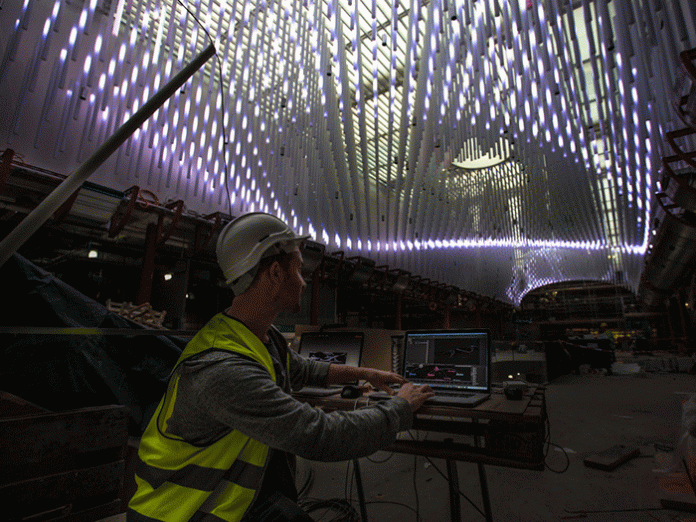London-based video architecture firm BAJT has created the volumetric content for DEX, the beautiful new sculptural video installation at the Mall of Scandinavia in Stockholm. BAJT was commissioned by Mediatec to showcase the full creative potential of the huge volumetric installation, which is 65 meters long and comprised of 3,800 LED strips, each with a maximum of 64 individually controlled pixels.
The Mall of Scandinavia is Scandinavia’s biggest shopping venue. It is located 5 kilometres from Stockholm’s city centre. DEX is a permanent architectural installation, mounted in the ceiling, which runs 24/7.
To meet the DEX challenge Mediatec and BAJT assembled a toolkit featuring the d3 creative suite, the Notch real-time 3D engine and Autodesk 3ds Max 3D animation software. BAJT used these tools to generate, visualise, sequence, and play back volumetric content in real-time. Content includes shimmering Northern Lights effects and three-dimensional wave patterns.
David Bajt who served as Content Creator and Media Engineer commented: “The main brief from the client was to create a Northern Lights look, which would further enhance the Scandinavian feel of the mall. I also chose to create another look: 3D waves flowing through the volume and utilising the rather magnificent scale of this installation.”
Magnus Lewren, Project Engineer from Mediatec also provided comments: “The goal was to use fluid effects to create a memorable and eye-catching display. The content also needed to help set a relaxing and joyful mood for the shoppers.”
To accomplish this Magnus and David generated and visualised the 3D content in Notch, baked the 3D content into the UV map in real-time, and sequenced and played back the content in d3 Technologies’ 2x2plus media server.
d3 was chosen for its ability to work with Notch to create real-time rendering of volumetric video. David stated that d3 is still the only media server that lets the content creator work independently of the technical limitations of LED processors. In practice this meant that as the content creator David could work with any formatted unwrap of the 3D model, create 3D content baked into the texture and use d3 to output video to the LED processor completely independent of the of the 3D model’s unwrap. David could also use d3’s feed view to chop up the un-wrap and re-arrange the UV map output to 3,800 individual strips.
David noted that he separating the creative and technical workflows, even though they are interlinked and how that has always been d3’s strong suit. d3 also allows the user to previse the volumetric content and because it’s so tightly integrated with Notch, the visual programming was done entirely within d3. Not a single video file is played back: It’s all Notch real-time generative content, sequenced by a d3 Designer connected to a d3 2x2plus server placed in a control room at some distance from the actual hall.
Magnus stated d3’s feed tools made “very fast” work of mapping the 3,800 LED strips according to the LED processors. He continued by explaining the following: “Being on site we could easily alter parameters live in d3 and see the effect in real-time on the LED structure. This was a real timesaver when it came to content production. We could directly see what speeds and colors worked best. And we didn’t have to pre-render every frame out as video.
That saved us half the workflow when producing the video. d3 and Notch superseded that time consuming workflow by rendering everything in real-time.”
The process also enabled the client to provide feedback on site during the whole production period. Changes could be very easily made right then and there with an instant effect on the LEDs.
The alternative of working traditionally with pre-rendered content would have been extremely slow and painful and not very appealing to the client. The traditional route would have required hours of waiting with no guarantees that the results would be right in the end.
d3 played a key role in the extensive pre-visualisation required by the project.
Going forward, Magnus spoke that the client would like the ability to alter colours and speeds of scenarios in DEX depending on different events and happenings in the Mall. This will be a cost-efficient solution using OSC and a handheld device. The client will have control over colors and speeds, within limitations easily set inside d3, using faders on a tablet.
Magnus later concluded about the pre-visualisation with the following: “We were able to create visualisations of the set up and different scenarios using d3 Designer. We also used d3 Designer to produce ‘Stage Movies’ so the client could get a good idea of the impact and feel of such a grand ceiling structure. The d3 2x2plus has been running solidly since the DEX installation was launched. Both hardware and software have been remarkably stable. I can’t recall a single issue with either d3’s software or hardware.”
https://www.d3technologies.com





